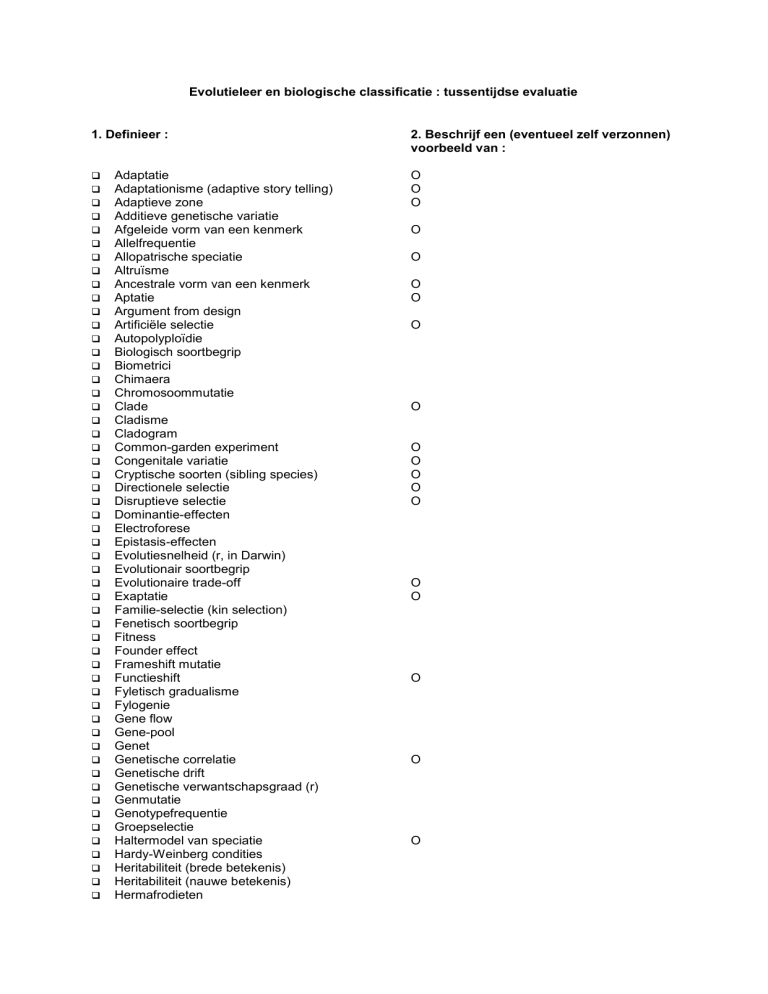
Evolutieleer en biologische classificatie : tussentijdse evaluatie
1. Definieer :
2. Beschrijf een (eventueel zelf verzonnen)
voorbeeld van :
O
O
O
Adaptatie
Adaptationisme (adaptive story telling)
Adaptieve zone
Additieve genetische variatie
Afgeleide vorm van een kenmerk
Allelfrequentie
Allopatrische speciatie
Altruïsme
Ancestrale vorm van een kenmerk
Aptatie
Argument from design
Artificiële selectie
Autopolyploïdie
Biologisch soortbegrip
Biometrici
Chimaera
Chromosoommutatie
Clade
Cladisme
Cladogram
Common-garden experiment
Congenitale variatie
Cryptische soorten (sibling species)
Directionele selectie
Disruptieve selectie
Dominantie-effecten
Electroforese
Epistasis-effecten
Evolutiesnelheid (r, in Darwin)
Evolutionair soortbegrip
Evolutionaire trade-off
Exaptatie
Familie-selectie (kin selection)
Fenetisch soortbegrip
Fitness
Founder effect
Frameshift mutatie
Functieshift
Fyletisch gradualisme
Fylogenie
Gene flow
Gene-pool
Genet
Genetische correlatie
Genetische drift
Genetische verwantschapsgraad (r)
Genmutatie
Genotypefrequentie
Groepselectie
Haltermodel van speciatie
Hardy-Weinberg condities
Heritabiliteit (brede betekenis)
Heritabiliteit (nauwe betekenis)
Hermafrodieten
O
O
O
O
O
O
O
O
O
O
O
O
O
O
O
O
Heterozygoot voordeel
Heterozygositeit (H)
Historische rem
O
Homologie
O
Homoplasie
O
Hopeful monster
Horizontaal genentransfer
Hybride zone (hybrid zone)
Hybriden
Inversie (chromosomen)
Kwantitatieve genetica
Lamarcks « transformationisme »
Macro-evolutie
Maternale effecten
O
Meiotic drive
Micro-evolutie
Monofyletisch
O
Monogenische beïnvloeding
Morfologisch soortbegrip
Motoo Kimura’s neutrale theorie van moleculaire evolutie
Mutatie
Mutatiesnelheid
Natuurlijke selectie
Nieuwe Synthese
Ontwikkelingsrem (developmental constraint)
O
Outgroup
Overdominantie
Parafyletisch
O
Parapatrische speciatie
O
Paraspecies of pseudospecies
Pendentief (spandrel)
O
Perifeer model van speciatie
O
Pleiotropie
O
Polariteit van een kenmerk in een fylogenie
O
Polyfyletisch
O
Polygenische beïnvloeding
Polymorfisme
O
Polyploïdie
Polytypische soorten
O
Populatiegenetica
Postzygotische isolatie
O
Preadaptatie
O
Prezygotische isolatie
O
Probleem van de tussenliggende schakels
O
Ramet
Reactienorm
O
Recombinatie
Redundant element
O
Reproductief succes
Reproductieve isolatie
O
Secundaire versterking (secundary reinforcement) O
Segregatiesjoemelaars (segregation distorters)
Sex-ratio distorters
Sleutelkenmerken
O
Stabiliserende selectie
O
Stasis
Sympatrische speciatie
O
Synapomorf
Synonieme mutatie
Theorie van de onderbroken evenwichten (punctuated equilibria)
Type specimen
Typologisch soortbegrip
Unequal crossing over
Weismanniaanse ontwikkeling
3. “Denk”vragen
Salamanders (en andere dieren) die in grotten leven zijn vaak blind. Hoe kan je dit fenomeen
evolutionair verklaren ? Stel een onderzoeksschema op om je ideeën te toetsen.
Vogelsoorten en keversoorten op afgelegen eilanden zijn vaak niet in staat te vliegen. Bedenk
verschillende verklaringen voor dit fenomeen. Hoe kan je te weten komen welk van die
verklaringen de juiste is ?
Hoe zou je homoseksualiteit evolutionair kunnen verklaren ?
4. “Opinie”vragen
Becommentarieer volgend excerpt uit het werk van Michael J. Behe.
How can we decide whether Darwinian natural selection can account for the amazing complexity that
exists at the molecular level? Darwin himself set the standard when he acknowledged, "If it could be
demonstrated that any complex organ existed which could not possibly have been formed by
numerous, successive, slight modifications, my theory would absolutely break down.”
…
Irreducibly complex systems appear very unlikely to be produced by numerous, successive, slight
modifications of prior systems, because any precursor that was missing a crucial part could not
function. Natural selection can only choose among systems that are already working, so the existence
in nature of irreducibly complex biological systems poses a powerful challenge to Darwinian theory.
We frequently observe such systems in cell organelles, in which the removal of one element would
cause the whole system to cease functioning. The flagella of bacteria are a good example. They are
outboard motors that bacterial cells can use for self-propulsion. They have a long, whiplike propeller
that is rotated by a molecular motor. The propeller is attached to the motor by a universal joint. The
motor is held in place by proteins that act as a stator. Other proteins act as bushing material to allow
the driveshaft to penetrate the bacterial membrane. Dozens of different kinds of proteins are
necessary for a working flagellum. In the absence of almost any of them, the flagellum does not work
or cannot even be built by the cell. The flagellum clearly is an example of intelligent design; the
random process of natural selection cannot explain flagellae.
De VRT organiseert een debat tussen creationisten en Darwinisten. U wordt door de
creationisten ingehuurd om wetenschappelijke argumenten aan te brengen tégen de
evolutieleer. Hoe ga je te werk ?
